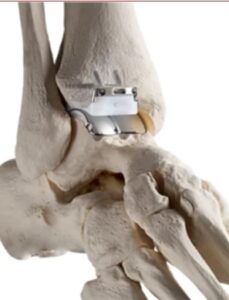Call Us for Consultation
(816) 317-5070
The human foot is a very complex structure divided into three sections containing 26 bones, 33 joints and more than 100 ligaments and muscles working together to achieve a unique flexible structure.
The three sections are:
- The forefoot, comprised of five toes (phalanges) and five longer bones (metatarsals).
- The midfoot, comprised of three cuneiform bones, the cuboid bone, and the navicular bone. This section of the foot forms the arch in your feet.
- The hindfoot is the section that includes the heel and ankle. The talus bone sits between the heel (calcaneus) and supports the leg bones (tibia and fibula). The calcaneus is the largest bone in the foot.
Problems can arise in any of these specialized structures, especially with active adults.
Anyone who has experienced an injury or broken bone to their foot and ankle can attest to how painful and inconvenient it can be you can’t move the around the way you have been accustomed. The freedom of movement is something we take for granted, whether it is the foot and ankle, back or neck, or another joint until an injury causes significant pain. Diagnosing your foot and ankle pain can prove difficult due to the complex structure of the feet and ankles. Trusting Greiner Orthopedics to accurately find the lower body issues you’re experiencing and helping you to regain your strength, flexibility and durability is something you can count on.
Problems that can occur in the Foot and Ankle
- Bunions
- Hammertoes
- Foot Arthritis
- Tendon injuries or tears
- Plantar Fasciitis
- Heel pain and bone spurs
- Ankle Arthritis
- Stress Fractures
- Ligament tears
- Sprains
Non-Surgical Treatment
- Steroid Injection Therapy: A key component to non-surgical pain management and critical to successful long-term management of recurrent foot and ankle pain. These injections can offer immediate relief for severe pain. This can be done for a multitude of foot and ankle injuries, from arthritis treatment to tendon injuries and ligament injuries.
- Fluoroscopic Tendon Sheath Injections: This procedure can treat small tendon tears as well as tendonitis with tendon sheath injections. This is done under an X-ray machine and the tendon is bathed in steroid to get rid of inflammation which is causing the pain. Greiner Orthopedics has the capabilities to do this and get people back to their activities faster.
- Custom Orthotics: Greiner Orthopedics is one of the few practices in the Kansas City metro area that use 3D imaging to create custom orthotics. A 3D image is taken of the bottom of the foot in the position it should be in when walking, and this is most accurate way to improve function and decrease pain in the lower leg with a custom orthotic. A full walking and motion exam will be performed the entire leg to assure the best orthotic is made for you. Come in and have yourself evaluated today!
Surgical Treatment
- Total Ankle Replacement
- Bunion surgery
- Hammertoe Repair
- Ankle Arthroscopy, Subtalar Joint Arthroscopy
- Flat Foot Reconstruction
- High Arch Reconstruction
- Ankle Ligament repair
- LisFranc ligament repair
- Ankle and Foot Fracture repair
- Plantar fascia release
- Achilles tendon repair
- Bone Spur removal
- Cartilage damage repair (OCD repair)
- Clean out procedures for arthritis of the foot and ankle
When is Foot and Ankle Surgery Necessary?
Foot and ankle surgery may become necessary when non-surgical alternatives like physical therapy or pain injection shots or tendon sheath injections are ineffective. The most common reasons for foot and ankle surgery originate from various types of arthritis, broken bones, ligament tears, tendon tears or foot and ankle deformities patients may have been born with or developed over time.
Ankle/Subtalar arthroscopy is typically the go-to technique for all orthopedic surgeries, including foot and ankle procedures. The surgeon makes a small incision on the affected area and uses small surgical tools and a fiber-optic camera to view where damage must be treated. Recovery time after foot or ankle arthroscopy is about four to six weeks after completion of the surgery.
Fracture repair: Is typically done when the ankle or foot bones are broken and out of place and needs to be done to repair and put everything back in its original place. Recovery time varies for this, but usually six to eight weeks after surgery.
Tendon tears repair: Sometimes the Achilles tendon or other tendons to the foot and ankle become torn from activities or wear and tear. The surgeon makes an incision over the tendon and repairs it with suture and makes it into a tube again instead of the tendon being flat and not useful. Recovery is dependent on the tendon that needs the repair.
Ligament repair: If you are having chronic ankle sprains or ankle instability, this may be the best procedure for you. After we have an ankle sprain sometimes the ligaments heal in a stretched-out position and the ankle feels loose all the time, or you roll your ankle a lot. What can be done is an arthroscopy procedure plus a incision over the ligaments to tighten them back up or reinforce them with suture so they do not stretch out again.
Bunions: There are a lot of different ways to fix a bunion. Bunion surgery can vary from a cut in the metatarsal bone and move it over or connecting 2 bones together and shifting the bone back where it should be, so the bunion does not return.
Total Ankle Replacement Surgery: This is done when the ankle has such bad arthritis in it that the ankle no longer can move correctly, or it is deformed and causes significant pain with day to day activities. This type of surgery is like a knee or hip replacement but at the ankle joint. The recovery for this is usually 8–12 weeks, but we can get you back to walking with this type of surgery.


